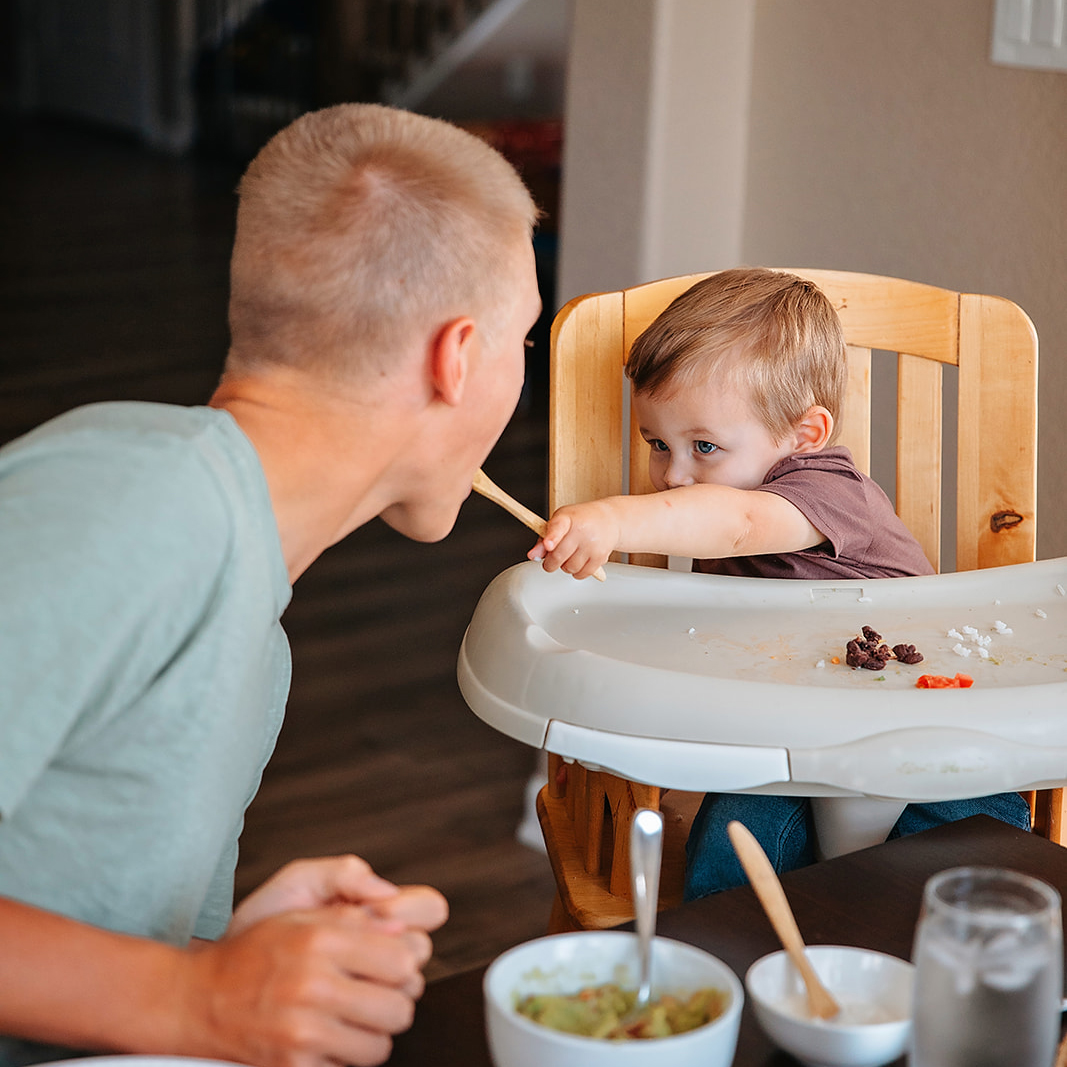Is your sweet child refusing to try new foods? You’re not alone! Use these simple steps to fix picky eating. Learn how to raise an adventurous eater!
 “But I don’t like this…”
“But I don’t like this…”
It’s possibly the most frustrating phrase to hear at the dinner table. After all, you’ve just spent your precious time planning, shopping, and preparing a beautiful meal.
And now your picky eater is refusing to eat. They’re demanding plain buttered noodles.
Meanwhile, you’re left wondering what to do. Are you about to become a short-order cook? Is your child getting enough to eat?
What’s a parent to do with a picky eater??
My friend, you are not alone. You are not a bad parent (!!!). There is a way to help your picky eater try (and even enjoy!) all kinds of foods.
Note: if your child is neurodivergent, feeding your picky eater may look different for your family. Consult with your pediatric dietitian to understand how to best support your child.
The “Division of Responsibility” is a way to define the roles for grown-ups and children to help parents raise healthy intuitive eaters.
The PARENT decides what, when, and where to offer food. The CHILD decides whether and how much to eat.
Defining these roles helps take the pressure off you as a parent to “make” your child eat. Children learn to listen to their hunger and fullness cues. Parents remain in charge of providing for the child’s nutritional needs by offering a variety of foods at consistent times during the day (see Tip #2).
Click here to read more about the Division of Responsibility.
How to Fix Picky Eating Tip #2: Offer Food on a Consistent Schedule
Little tummies get hungry more often than adults! Kiddos simply can’t eat large portions. Plan to offer a meal or snack about every 3 hours. This usually works out to about 3 meals and 2-3 snacks per day.
Your schedule doesn’t have to be super strict. It’s okay to fudge the timing by 15 or 30 minutes if you need to be somewhere or if your child is really hungry.
However, having a fairly consistent eating schedule has several BIG benefits.
A Consistent Eating Schedule Helps Picky Eaters Know What to Expect
Toddler brains LOVE consistency and knowing what to expect.
After a few days of saying “no” to a snack in between meals and snack time, your child will start to understand the pattern. This equals less whining and fewer tantrums during the day. Who doesn’t love that?
A Consistent Eating Schedule Helps Caregivers of Picky Eaters Worry Less
Sometimes your kiddo won’t eat ANYTHING on their plate at a meal, or they might refuse a snack completely.
When you offer food every 2-3 hours, it’s not as big of a deal if you child skips a meal. They’ll have a chance to eat again soon so they won’t go hungry.
This reinforces your child’s confidence in their own ability to listen to their body. It also helps YOU as the caregiver worry less about if they’re getting enough to eat.
A Consistent Eating Schedule Helps Picky Eaters Try New Foods
It’s easy to get into the trap of “grazing,” snacking continuously between meals. If you can avoid this, your child will be hungrier before the next meal. A hungry child is usually more willing to try different foods.
What happens if your child drinks a cup of milk and eats crackers all morning? They’ll be full (or at least full enough) that they won’t be interested in the meal you spent all that time preparing.
As much as possible, try to avoid allowing your child to “graze” on snacks in between your planned eating times.

How to Fix Picky Eating Tip #3: Eat Meals Together
Like it or not, kids do as we do. Having family meals together is a great way to model what healthy eating looks like.
Avoid Praise and Negative Food Comments to Help your Picky Eater
Keep family meals low-pressure. When it comes to trying new foods, it’s better to say NOTHING than saying either something positive or negative.
Yes, that’s right – it might seem like praising your child for eating a new food would be helpful. In the long-run, this can backfire.
Too much praise at a meal can shift your child to eat for praise rather than listening to their internal hunger cues. Sometimes praise can simply be overwhelming and your child might shrink away from trying new foods.
Make Family Mealtime Fun to Help your Picky Eater
Having fun at mealtimes is one of the best ways to help your picky eater!
Instead of focusing on what everyone is eating, have a conversation with your child. Ask them about their day. Look outside the window with your toddler and notice what’s going on in your neighborhood.
Incorporate play into mealtimes! Try re-imagining the broccoli as little trees standing in the mashed potato snow, or the Brussels sprouts as soccer balls.
If family meals are becoming frustrating because you’re worried your child isn’t eating enough, go back to the division of responsibility. Allow your child to listen to their body and leave a meal even if they haven’t eaten much. Because you’re on a predictable eating schedule, the next meal or snack time will come along soon!

How to Fix Picky Eating Tip #4: Try Foods Over and Over!
Did you know it can take up to TWENTY exposures to a new food before the brain can truly figure out if it’s a “like” or “dislike?
It’s rare that your picky eater will like a new food the first time they try it. Don’t give up! Provide lots of chances for your picky eater to experience new and different foods.
Include New Foods at the Table (Even if Your Picky Eater Doesn’t Eat Them)
Your child doesn’t even have to eat the food for it to count as an “exposure!”
Let your child see the food on the table and watch you enjoy it. This will help your child move through the “dislike” phase faster. Soon they’ll be more open to trying a food they previously didn’t like.
Include a “Safe Food” at Every Meal
A “safe food” is one you know your child likes. Serving a “safe food” alongside the meal takes the pressure off you and your child because you know there is at least one food they’re willing to eat.
For example, my toddler is in a “no-meat” phase. If we’re serving chicken, I also serve a couple of slices of cheese to him. He usually eats a tiny bite of chicken but ends up getting most of his protein from cheese.
In my book, this is a win! My child had an “exposure” to chicken even if he didn’t eat a lot or didn’t particularly like it at the meal.
Focus on Whole Foods
 As you’re planning your meals, include lots of fresh fruits, home-cooked vegetables, and unprocessed proteins.
As you’re planning your meals, include lots of fresh fruits, home-cooked vegetables, and unprocessed proteins.
Ultra-processed foods like chips, chicken nuggets, and candy have been engineered to what’s called the “Bliss Point” of taste. The “bliss point” is the trifecta of the flavors sugar, salt, and fat. When we eat a lot of these “bliss point” foods, fresh foods can taste very bland in comparison.
I know getting dinner on the table every night is a challenge in and of itself. If you’re trying to also focus on nutrition, it can feel overwhelming.
That’s why I created the Peas and Hoppy Meal Guide Membership: to make it easier to get a healthy dinner on the table for busy families.
If you’re looking for an answer to what to cook for dinner, start a free trial of the membership. You’ll get instant access to your weekly seasonal menu, made-for-you grocery list, and over 800 healthy recipes for you to customize your menu every week.
How to Fix Picky Eating Tip #5: Involve Picky Eaters in the Preparation & Cooking Process
Inviting your kids into the meal planning and cooking process is one of the BEST ways to help them overcome a fear of trying new foods.
If your child grows the carrot, picks the carrot, slices the carrot, and cooks the carrot, they’re going to be so invested in that carrot that they won’t be able to wait to try it!
You don’t have to involve your kids in every single meal. Try picking a special day once a month and take a trip to the farmer’s market or grocery store. Let your kids choose a veggie they’ve never seen before (make it a scavenger hunt!). You can learn together how to prepare it.
How to Fix Picky Eating Tip #6: Keep Food Morally Equivalent
Giving moral value to food is very common in our diet-influenced culture. For example, food morality might look like a “sinful dessert.” You might feel you’ve “been good” for eating a salad for lunch.
To allow your child to develop a healthy relationship with food, keep food morally equal when you talk about it.
Keep Food Talk Neutral
 The idea of “good foods” and “bad foods” teaches kids that certain foods are special, off limits, or need to be earned.
The idea of “good foods” and “bad foods” teaches kids that certain foods are special, off limits, or need to be earned.
Eating the “bad foods” can cause older children and adults to feel guilty or shameful for enjoying these foods. In the long run, this can lead to an unhealthy relationship with food, such as sneaking food or binge eating these off-limit foods.
On the other hand, foods labeled as “good” or “healthy” might lose their appeal. If vegetables are only used for health or to get to dessert, you might not notice that you enjoy the flavor.
It’s true some foods have different nutrients in them. When talking about different foods to your kids, try and let go of the guilt in language that is often associated with food in diet culture.
Avoid Food Bribes
Food bribes are a way in which we can unintentionally introduce the idea of food morality.
For example, it’s common to only allow dessert once your child has eaten dinner – a “food bribe” for cleaning their plate. Instead, consider serving dessert WITH the meal, or simply offering dessert without any comment about how much your child has eaten at the meal.
You might be surprised that your child naturally limits the amount of sweets they eat. It’s normal to tire of one flavor and move onto another. It’s easier to do this when your child knows they’ll be allowed to have more of this food in the future.
Offer your Child a Variety of Food
Keeping food morally equivalent does NOT mean you need to let your kiddo have cookies for breakfast every day.
Cookies have energy, but you as the grown-up know they don’t have a lot of other nutrients your kiddo needs.
Follow your role in the Division of Responsibility (Tip #1) and continue to offer your child a wide variety of foods from all the food groups. This includes dessert, but it doesn’t mean that dessert needs to be at every meal.
How to Fix Picky Eating Tip #7: Play the Long Game
Parenting is a long game, and so is food. Remember there is not one snack, meal, or day of eating which will make or break your child’s health.
Focus on the Big Picture
It’s very normal for your child to go through phases of picky eating and food preferences. Some days they’ll be very hungry and eat a LOT; other days they’ll barely touch their food.
These waves can seem really rocky when you’re in the middle of it, but as long as your child is growing appropriately, this is all perfectly normal.
Avoid Labeling Your Child as a Picky Eater
As you navigate this phase, try not to label your child as a picky eater.
Labeling your child can accidentally become a self-fulfilling prophecy. If your child believes they’re a picky eater, they might be less willing to try new foods.
It can also (perhaps subconsciously) cause you as the parent to stop offering as many new foods.
Don’t Hide Ingredients in Food
When you’re in the thick of a picky eating phase and your child isn’t eating much variety, it’s SO tempting to sneak vegetables into foods. This could look like spinach tucked into a casserole, veggies blended into mac & cheese, or chicken nuggets baked with extra veggies into them.
Unfortunately, hiding food tends to backfire in the long run because:
- Children don’t gain exposure to new foods. Or at least, they don’t realize they’re getting the exposure – so the exposure doesn’t really count.
- It can erode the trust between you and your child. You said the mac & cheese was just like normal. But then they found a teeny tiny piece of butternut squash that didn’t get mashed up. How will they ever trust you agaaaaain??? *enter: wailing toddler*
If you DO want to add extra veggies into your casseroles or soups or smoothies, that’s great! Just be honest about this with your kiddo so they don’t feel like you’ve lied to them.

Stay Consistent to Help your Picky Eater Like New Foods
If you consistently practice these seven tips with your family, your picky eater will learn to love all kinds of food!
I know it can seem overwhelming to think about fixing picky eating when you’re scrambling to just get dinner on the table every night. You are certainly not alone!
This is why I created the Peas & Hoppy Meal Guide Membership. Our customizable meal planning service saves you tons of time with fresh meal ideas that are nutritionally balanced and full of flavor.
When you join the membership, you get a new menu every week full of fresh, seasonal ideas for breakfast, lunch, and dinner. Use the Meal Guide app to switch out recipes and adjust serving sizes to customize your menu. This automatically updates the made-for-you grocery list so you save time and money at the grocery store.
It’s possible for you to become the family who sits down to a home-cooked meal together! The Peas & Hoppy Meal Guides can help you get there.
Please remember: you’re doing great. Raising adventurous eaters is about practice and consistency – not perfection. Simply by being here and asking these questions, I know you care deeply about your family’s well-being.
Your family is lucky to have you.
In eating adventure,
Dietitian Ann from Peas and Hoppiness
A Meal Planning Service for Busy Families
The Peas & Hoppy Meal Guide Membership is a weekly plant-forward meal planning service which helps busy families get a healthy dinner on the table.
Start your free trial for access to our app, including your weekly customizable menu, made-for-you grocery list, and over 800 dietitian-approved recipes.
“I love the balanced meals and variety of food choices the guides provide. The meals are filling, taste good, and are nutritious.”
-Rhonda, member of the Peas & Hoppy Meal Guides


2 thoughts on “7 Tips to Help your Picky Eater Like More Foods”
Hello, My son is almost 4 years old and he refuses to eat mostly all kind of food and I don’t know what to do with him, I am in a real crossroad. Please advise thanks
Hi Klei! I’m sorry to hear about your struggles – it’s so challenging. It depends on each individual kiddo how is best to help. I’d recommend to talk with your pediatrician and make sure your son’s growth is on track. It might be helpful to work with a pediatric dietitian. If you’d like to chat more, you can book a 1-1 consultation with me and I’d be happy to walk you through your options.